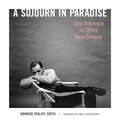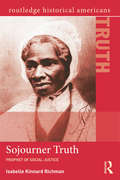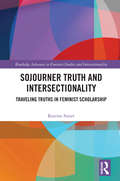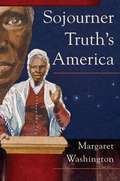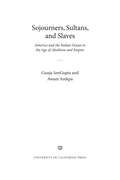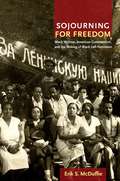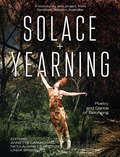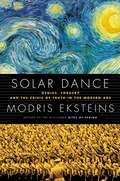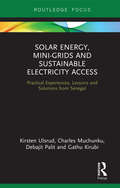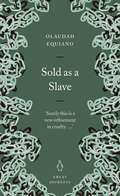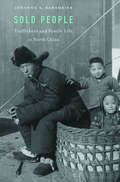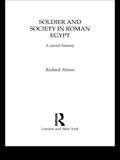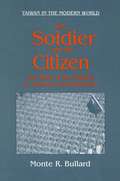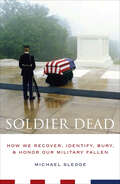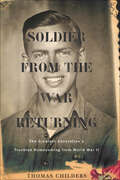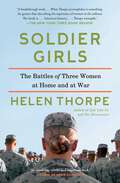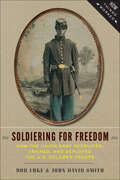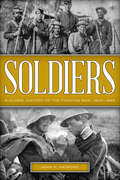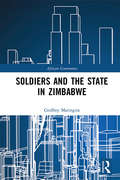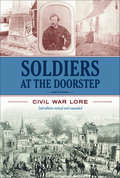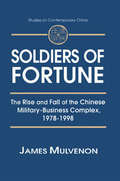- Table View
- List View
A Sojourn in Paradise: Jack Robinson in 1950s New Orleans
by Howard Philips SmithJack Robinson made his name as a much-sought-after fashion and celebrity photographer during the 1960s and early 1970s, and his work is well documented in hundreds of pages of Vogue, the New York Times, and Life, as well as other publications. However, his personal life remains virtually unknown. In this study of Robinson and his photography, Howard Philips Smith takes an in-depth look at Robinson’s early life in New Orleans, where he discovered his passion for painting, photography, and the Dixie Bohemian life of the French Quarter. A Sojourn in Paradise: Jack Robinson in 1950s New Orleans features more than one hundred photographs taken by the artist, accompanied by detailed commentary about Robinson’s life in New Orleans and excerpts from interviews with the people who knew him when he lived there. Robinson’s photographs of New Orleans reveal the genesis of two unique and fascinating facets of the city’s history and culture: the creation of the first gay Carnival krewes who would make their own unique contribution to the rich cultural history of the city and the formation of the Orleans Gallery, one of the earliest centers of the contemporary art movement blossoming in 1950s America. This detailed study of Jack Robinson’s early life and photography illustrates the contributions of a gifted, gay artist whose quiet spirit and constant interior struggle found refuge in New Orleans, the city where he was able to find himself, for a time, free from society’s grip and open to exploring life on his own terms.
Sojourner Truth: Prophet of Social Justice (Routledge Historical Americans)
by Isabelle Kinnard RichmanAlthough Sojourner Truth was born into bondage and oppression, in liberation she emerged as a leader in the most radical causes of her era. She travelled the country as an outspoken and riveting presence, battling for the abolition of slavery and for women’s suffrage. While her role in these movements has been well-documented, biographers have frequently overlooked the influence of religion in Truth’s life. A participant in a number of the most significant religious movements of her day, including the Methodist Perfectionists, the Kingdom of Matthias, the Utopians, and the Spiritualists, Truth drew her notions of justice from religion. Sojourner Truth: Prophet of Social Justice provides a concise biography of this important figure, integrating her religious life in ways that shed light on Truth’s work and the religious movements of her day. Accompanied by primary source documents including political records, speech transcripts, and selections from her autobiography, Richman's biography provides a rich and accessible narrative of Truth's life and legacy.
Sojourner Truth and Intersectionality: Traveling Truths in Feminist Scholarship (Routledge Advances in Feminist Studies and Intersectionality)
by Katrine SmietSojourner Truth and Intersectionality investigates how the story of the 19th-century abolitionist and women’s rights advocate Sojourner Truth has come to be an iconic feminist story, and explores the continued relevance of this story for contemporary feminist debates in general, and intersectionality scholarship in particular. Tracing various academic reception histories of the story of Sojourner Truth and the famous "Ain’t I a Woman?" speech, the book gives insight into how this story has been taken up by feminist scholars in different times, places, and political contexts. Exploring in particular how and why the story of Sojourner Truth has become a key reference for the theoretical and political framework of intersectionality, the book examines what the consequences of this connection are both for how intersectionality is understood today, and how the story of Sojourner Truth is approached. The book examines key intersecting dimensions within the story of Truth and its reception, including gender, race, class and religion. This book will be of interest to students and scholars in gender, women’s and feminist studies. In particular, the book will be of interest to those wishing to learn more about intersectionality and Sojourner Truth.
Sojourner Truth's America
by Margaret WashingtonThis fascinating biography tells the story of nineteenth-century America through the life of one of its most charismatic and influential characters: Sojourner Truth. In an in-depth account of this amazing activist, Margaret Washington unravels Sojourner Truth's world within the broader panorama of African American slavery and the nation's most significant reform era. Born into bondage among the Hudson Valley Dutch in Ulster County, New York, Isabella was sold several times, married, and bore five children before fleeing in 1826 with her infant daughter one year before New York slavery was abolished. In 1829, she moved to New York City, where she worked as a domestic, preached, joined a religious commune, and then in 1843 had an epiphany. Changing her name to Sojourner Truth, she began traveling the country as a champion of the downtrodden and a spokeswoman for equality by promoting Christianity, abolitionism, and women's rights. Gifted in verbal eloquence, wit, and biblical knowledge, Sojourner Truth possessed an earthy, imaginative, homespun personality that won her many friends and admirers and made her one of the most popular and quoted reformers of her times. Washington's biography of this remarkable figure considers many facets of Sojourner Truth's life to explain how she became one of the greatest activists in American history, including her African and Dutch religious heritage; her experiences of slavery within contexts of labor, domesticity, and patriarchy; and her profoundly personal sense of justice and intuitive integrity. Organized chronologically into three distinct eras of Truth's life, Sojourner Truth's America examines the complex dynamics of her times, beginning with the transnational contours of her spirituality and early life as Isabella and her embroilments in legal controversy. Truth's awakening during nineteenth-century America's progressive surge then propelled her ascendancy as a rousing preacher and political orator despite her inability to read and write. Throughout the book, Washington explores Truth's passionate commitment to family and community, including her vision for a beloved community that extended beyond race, gender, and socioeconomic condition and embraced a common humanity. For Sojourner Truth, the significant model for such communalism was a primitive, prophetic Christianity. Illustrated with dozens of images of Truth and her contemporaries, Sojourner Truth's America draws a delicate and compelling balance between Sojourner Truth's personal motivations and the influences of her historical context. Washington provides important insights into the turbulent cultural and political climate of the age while also separating the many myths from the facts concerning this legendary American figure.
Sojourners, Sultans, and Slaves: America and the Indian Ocean in the Age of Abolition and Empire
by Gunja SenGupta Awam AmkpaIn the nineteenth century, global systems of capitalism and empire knit the North Atlantic and Indian Ocean worlds into international networks in contest over the meanings of slavery and freedom. Sojourners, Sultans, and Slaves mines multinational archives to illuminate the Atlantic reverberations of US mercantile projects, "free labor" experiments, and slaveholding in western Indian Ocean societies. Gunja SenGupta and Awam Amkpa profile transnational human rights campaigns. They show how the discourses of poverty, kinship, and care could be adapted to defend servitude in different parts of the world, revealing the tenuous boundaries that such discourses shared with liberal contractual notions of freedom. An intercontinental cast of empire builders and émigrés, slavers and reformers, a "cotton queen" and courtesans, and fugitive "slaves" and concubines populates the pages, fleshing out on a granular level the interface between the personal, domestic, and international politics of "slavery in the East" in the age of empire. By extending the transnational framework of US slavery and abolition histories beyond the Atlantic, Gunja SenGupta and Awam Amkpa recover vivid stories and prompt reflections on the comparative workings of subaltern agency.
Sojourning for Freedom: Black Women, American Communism, and the Making of Black Left Feminism
by Erik S. McduffieSojourning for Freedom portrays pioneering black women activists from the early twentieth century through the 1970s, focusing on their participation in the U. S. Communist Party (CPUSA) between 1919 and 1956. Erik S. McDuffie considers how women from diverse locales and backgrounds became radicalized, joined the CPUSA, and advocated a pathbreaking politics committed to black liberation, women's rights, decolonization, economic justice, peace, and international solidarity. McDuffie explores the lives of black left feminists, including the bohemian world traveler Louise Thompson Patterson, who wrote about the "triple exploitation" of race, gender, and class; Esther Cooper Jackson, an Alabama-based civil rights activist who chronicled the experiences of black female domestic workers; and Claudia Jones, the Trinidad-born activist who emerged as one of the Communist Party's leading theorists of black women's exploitation. Drawing on more than forty oral histories collected from veteran black women radicals and their family members, McDuffie examines how these women negotiated race, gender, class, sexuality, and politics within the CPUSA. In Sojourning for Freedom, he depicts a community of radical black women activist intellectuals who helped to lay the foundation for a transnational modern black feminism.
The Solace of Stones: Finding a Way through Wilderness (American Lives)
by Julie RiddleEverything changes when Julie Riddle’s parents stumble across the wilderness survival guide How to Live in the Woods on Pennies a Day. In 1977, when Riddle is seven years old, she and her family—fed up with the challenges of city life—move to the foot of the Cabinet Mountains Wilderness in northwestern Montana. For three years they live in the primitive basement of the log house they are building by hand in the harsh, remote Montana woods. Meanwhile, haunted by the repressed memory of childhood sexual abuse, Riddle struggles to come to terms with the dark shadows that plague her amid entrenched cultural and gender mores enforced by enduring myths of the West. As Riddle grapples with her own painful secrets, she discovers the world around her and its impact on people—the demands of living in a rural, mountain community dependent on boom-and-bust mining and logging industries, the health and environmental crises of the W. R. Grace asbestos contamination and EPA cleanup, and the healing beauty of the Montana wild. More than simply a memoir about family and place, The Solace of Stones explores Riddle’s coming of age and the complexities of memory, loss, and identity borne by a family homesteading in the modern West.
Solace + Yearning – Poetry of Dance and Belonging: A Community Arts Project from Denmark, Western Australia
by Annette Carmichael‘Solace + Yearning’ layers landscape, poetry, eco-art and contemporary dance to create an immersive space for many voices: yearning to connect to country, grief for what is absent, and reaching towards an understanding of indigenous language and culture. “Along the edges, voices call softly, softly… the past speaking to the present.” This multi-arts collaboration explores ‘settler guilt’ and ‘solastalgia’—a sense of loss caused by environmental change—in a small rural community. The work unravels contradictory and complicated feelings about Australia’s stories, the assumed advantage of non-indigenous Australians, and yet our deep longing for the wisdom and connection intrinsic in indigenous cultures. “It is beneath the bark where stories are whispered and life rises to stitch together this river with this sky.” Performed in Denmark, Western Australia in 2012, and again as a solo performance by Annette Carmichael in 2014, these images and reflections portray a complex relationship between people and place. “Sometimes, sometimes I make the mistake of thinking that what has not been written down has been forgotten.” With gratitude to Joey Williams, Wayne Webb, Toni Webb, and Harley Coyne, who walked the trail with us and generously shared their Noongar culture and stories.
Solar Dance
by Modris EksteinsIn Solar Dance, acclaimed writer and scholar Modris Eksteins uses Vincent van Gogh as his lens for this brilliant survey of Western culture and politics in the last century. The long-awaited follow-up to Modris Eksteins' internationally acclaimed Rites of Spring and Walking Since Daybreak. Now he has produced another thrilling, iconoclastic work of cultural history that is a trailblazing biography of an era--from the eve of the First World War and the rise of Hitler to the fall of the Berlin Wall--that illuminates our current world, with its cults of celebrity and the crisis of the authentic. Solar Dance is a penetrating examination of legitimacy and truth, fakery and pretence--highly relevant to all of us today.From the Hardcover edition.
Solar Energy, Mini-grids and Sustainable Electricity Access: Practical Experiences, Lessons and Solutions from Senegal (Routledge Focus on Environment and Sustainability)
by Debajit Palit Kirsten Ulsrud Charles Muchunku Gathu KirubiThis book presents new research on solar mini-grids and the ways they can be designed and implemented to provide equitable and affordable electricity access, while ensuring economic sustainability and replication. Drawing on a detailed analysis of solar mini-grid projects in Senegal, the book provides invaluable insights into energy provision and accessibility which are highly relevant to Sub-Saharan Africa, and the Global South more generally. Importantly, the book situates mini-grids in rural villages within the context of the broader dynamics of national- and international-level factors, including emerging system innovation and socio-technical transitions to green technologies. The book illustrates typical challenges and potential solutions for practitioners, policymakers, donors, investors and international agencies. It demonstrates the decisive roles of suitable policies and regulations for private-sector-led mini-grids and explains why these policies and regulations must be different from those that are designed as part of an established, centralized electricity regime. Written by both academics and technology practitioners, this book will be of great interest to those researching and working on energy policy, energy provision and access, solar power and renewable energy, and sustainable development more generally.
Sold as a Slave (Great Journeys Ser. #No. 8)
by Olaudah EquianoIn an adventurous and extraordinary life, Equiano (c.1745-c.1797) criss-crossed the Atlantic world, from West Africa to the Caribbean to the USA to Britain, either as a slave or fighting with the Royal Navy. His account of his life is not only one of the great documents of the abolition movement, but also a startling, moving story of danger and betrayal.Great Journeys allows readers to travel both around the planet and back through the centuries – but also back into ideas and worlds frightening, ruthless and cruel in different ways from our own. Few reading experiences can begin to match that of engaging with writers who saw astounding things: Great civilisations, walls of ice, violent and implacable jungles, deserts and mountains, multitudes of birds and flowers new to science. Reading these books is to see the world afresh, to rediscover a time when many cultures were quite strange to each other, where legends and stories were treated as facts and in which so much was still to be discovered.
Sold People: Traffickers and Family Life in North China
by Johanna S. RansmeierTrade in human lives thrived in North China during the Qing and Republican periods. Families at all social levels participated in buying servants, slaves, concubines, or children and disposing of unwanted household members. Johanna Ransmeier shows that these commonplace transactions built and restructured families as often as it broke them apart.
Soldaderas in the Mexican Military: Myth and History
by Elizabeth SalasThis study explores the evolving role of women soldiers in Mexico—as both fighters and cultural symbols—from the pre-Columbian era to the present.Since pre-Columbian times, soldiering has been a traditional life experience for innumerable women in Mexico. Yet the many names given these women warriors—heroines, camp followers, Amazons, coronelas, soldadas, soldaderas, and Adelitas—indicate their ambivalent position within Mexican society. In this original study, Elizabeth Salas challenges many traditional stereotypes, shedding new light on the significance of these women.Drawing on military archival data, anthropological studies, and oral history interviews, Salas first explores the real roles played by Mexican women in armed conflicts. She finds that most of the functions performed by women easily equate to those performed by revolutionaries and male soldiers in the quartermaster corps and regular ranks. She then turns her attention to the soldadera as a continuing symbol, examining the image of the soldadera in literature, corridos, art, music, and film.Salas finds that the fundamental realities of war link all Mexican women, regardless of time period, social class, or nom de guerre.
Soldier and Society in Roman Egypt: A Social History
by Richard AlstonThe province of Egypt provides unique archaeological and documentary evidence for the study of the Roman army. In this fascinating social history Richard Alston examines the economic, cultural, social and legal aspects of a military career, illuminating the life and role of the individual soldier in the army.Soldier and Society in Roman Eygpt provides a complete reassessment of the impact of the Roman army on local societies, and convincingly challenges the orthodox picture. The soldiers are seen not as an isolated elite living in fear of the local populations, but as relatively well-integrated into local communities. The unsuspected scale of the army's involvement in these communities offers a new insight into both Roman rule in Egypt and Roman imperialism more generally.
The Soldier and the Citizen: Role of the Military in Taiwan's Development (Taiwan In The Modern World Ser.)
by Monte R. BullardA soldier-citizen describes the role of the Republic of China's military in the political socialization of Taiwan's citizens during the first two decades after the loss of the Chinese mainland.
Soldier Dead: How We Recover, Identify, Bury, & Honor Our Military Fallen
by Michael SledgeThe first book to address the complicated issues surrounding what happens to members of the United States Armed Forces after they die. Why does recovering the remains of servicepeople matter? Soldier Dead examines this question and provides a thorough analysis of the processes of recovery, identification, return, burial, and remembrance of the dead. Sledge traces the ways in which the handling of our Soldier Dead has evolved over time and how these changes have reflected not only advances in technology and capabilities but also the shifting attitudes of the public, government, and military. He also considers the emotional stress experienced by those who handle the dead; the continuing efforts to retrieve bodies from Korea and elsewhere; and how unresolved issues regarding the treatment of enemy dead continue to affect U.S. foreign relations. Skillfully incorporating excerpts from interviews, personal correspondence and diaries, military records, and journalistic accounts—as well as never-before-published photographs and his own reflections—Michael Sledge presents a clear, concise, and compassionate story about what the dead mean to the living. Throughout Soldier Dead, the voices of the fallen are heard, as are those of family members and military personnel responsible for the dead before final disposition. At times disturbing and at other times encouraging, they are always powerful as they speak of danger, duty, courage, commitment, and care. &“A timely and detailed investigation into the moral conscience of American society which will be of interest to anyone concerned with the human costs of war. An important and passionate book which deserves a wide readership.&”—Chris Shilling, University of Portsmouth, UK
Soldier From The War Returning: The Greatest Generation's Troubled Homecoming from World War II
by Thomas ChildersA revelatory social history examining the lives of American military veterans after their return home following World War II.“Thomas Childers’s heartbreaking book makes palpable the human cost of a conflict too often sanitized as ‘the good war.’” —Chicago TribuneOne of our most enduring national myths surrounds the men and women who fought in the so-called “Good War.” The Greatest Generation, we’re told by Tom Brokaw and others, fought heroically, then returned to America happy, healthy and well-adjusted. They quickly and cheerfully went on with the business of rebuilding their lives.In this shocking and hauntingly beautiful book, historian Thomas Childers shatters that myth. He interweaves the intimate story of three families—including his own—with a decades’ worth of research to paint an entirely new picture of the war’s aftermath. Drawing on government documents, interviews, oral histories and diaries, he reveals that 10,000 veterans a month were being diagnosed with psycho-neurotic disorder (now known as PTSD). Alcoholism, homelessness, and unemployment were rampant, leading to a skyrocketing divorce rate. Many veterans bounced back, but their struggle has been lost in a wave of nostalgia that threatens to undermine a new generation of returning soldiers.Novelistic in its telling and impeccably researched, Childers’s book is a stark reminder that the price of war is unimaginably high. The consequences are human, not just political, and the toll can stretch across generations.“Childers’s absorbing study offers an important corrective to sanitized tributes to the Good War’s legacy.” —Publishers Weekly“A powerful work of social history that readers will stay with to the last page.” —Booklist
Soldier Girls: The Battles of Three Women at Home and at War
by Helen ThorpeFrom an award-winning, "meticulously observant" (The New Yorker), and "masterful" (Booklist) writer comes a groundbreaking account of three women deployed to Afghanistan and Iraq, and how their military service affected their friendship, their personal lives, and their families.America has been continuously at war since the fall of 2001. This has been a matter of bitter political debate, of course, but what is uncontestable is that a sizeable percentage of American soldiers sent overseas in this era have been women. The experience in the American military is, it's safe to say, quite different from that of men. Surrounded and far outnumbered by men, imbedded in a male culture, looked upon as both alien and desirable, women have experiences of special interest. In Soldier Girls, Helen Thorpe follows the lives of three women over twelve years on their paths to the military, overseas to combat, and back home...and then overseas again for two of them. These women, who are quite different in every way, become friends, and we watch their interaction and also what happens when they are separated. We see their families, their lovers, their spouses, their children. We see them work extremely hard, deal with the attentions of men on base and in war zones, and struggle to stay connected to their families back home. We see some of them drink too much, have illicit affairs, and react to the deaths of fellow soldiers. And we see what happens to one of them when the truck she is driving hits an explosive in the road, blowing it up. She survives, but her life may never be the same again. Deeply reported, beautifully written, and powerfully moving, Soldier Girls is truly groundbreaking.
Soldiering for Freedom: How the Union Army Recruited, Trained, and Deployed the U.S. Colored Troops (How Things Worked)
by Bob Luke John David SmithThe story of an enormous step forward in both the struggle for black freedom and the defeat of the Confederacy: turning former enslaved men into Union soldiers.After President Lincoln issued the final Emancipation Proclamation of January 1, 1863, Confederate slaves who could reach Union lines often made that perilous journey. A great many of the young and middle-aged among them, along with other black men in the free and border slave states, joined the Union army. These U.S. Colored Troops (USCT), as the War Department designated most black units, materially helped to win the Civil War—performing a variety of duties, fighting in some significant engagements, and proving to the Confederates that Northern manpower had practically no limits.Soldiering for Freedom explains how Lincoln’s administration came to recognize the advantages of arming free blacks and former slaves and how doing so changed the purpose of the war. Bob Luke and John David Smith narrate and analyze how former slaves and free blacks found their way to recruiting centers and made the decision to muster in. As Union military forces recruited, trained, and equipped ex-slave and free black soldiers in the last two years of the Civil War, white civilian and military authorities often regarded the African American soldiers with contempt. They relegated the men of the USCT to second-class treatment compared to white volunteers. The authors show how the white commanders deployed the black troops, and how the courage of the African American soldiers gave hope for their full citizenship after the war.Including twelve evocative historical engravings and photographs, this engaging and meticulously researched book provides a fresh perspective on a fascinating topic. Appropriate for history students, scholars of African American history, or military history buffs, this compelling and informative account will provide answers to many intriguing questions about the U.S. Colored Troops, Union military strategy, and race relations during and after the tumultuous Civil War.
Soldiering Under Occupation
by Erella GrassianiOften, violent behavior or harassment from a soldier is dismissed by the military as unacceptable acts by individuals termed, "rotten apples." In this study, the author argues that this dismissal is unsatisfactory and that there is an urgent need to look at the (mis)behavior of soldiers from a structural point of view. When soldiers serve as an occupational force, they find themselves in a particular situation influenced by structural circumstances that heavily influence their behavior and moral decision-making. This study focuses on young Israeli men and their experiences as combat soldiers in the Israeli Defense Forces (IDF), particularly those who served in the "Occupied Palestinian Territories" (OPT) during the "Al Aqsa Intifada," which broke out in 2000. In describing the soldiers' circumstances, especially focusing on space, the study shows how processes of numbing on different levels influence the (moral) behavior of these soldiers.
Soldiers: A Global History of the Fighting Man, 1800–1945
by John A HaymondA global study of how soldiers lived, worked, and fought, and how many died, spanning from the Napoleonic War to World War II. No matter the war, no matter the army, no matter the nationality, common threads run through the experiences of men at war. Soldiers highlights these shared experiences across 150 years of warfare, from the Napoleonic Wars through World War II and everything in between, such as the Mexican and Crimean Wars, the American Civil War, the U.S. Indian Wars and Britain&’s imperial bush wars, the Boxer Rebellion, the Boer War, the First World War, and more. Haymond explores the experiences that connect soldiers across time and space and draws heavily from firsthand accounts to craft a narrative with flesh-and-blood immediacy. Soldiers is entertaining and informative: history at its best. Praise for Soldiers&“What makes Soldiers an interesting read is Haymond&’s writing style and technique of comparing the common experiences of fighting men regardless of uniform and time served during the period.... Highly recommended for both scholars and students alike. It is a must for readers interested in the experience and psychology of being a warrior during this period.&”—Military Review: The Professional Journal of the United States Army
Soldiers and the State in Zimbabwe (African Governance)
by Godfrey MaringiraThis book explores the barrack experiences of soldiers in post-independence Zimbabwe, examining the concept of military professionalism within a state in political crisis. Drawing upon interviews with former soldiers of the Zimbabwe National Army, Soldiers and the State in Zimbabwe casts a light on the oppression of soldiers by commanders who sought to repress and control the political thinking of their men. By contextualising the political, economic and material conditions in which Zimbabwean soldiers existed, Godfrey Maringira reveals the everyday victimisation and violence of the barracks. Exploring such events as the imposition of the Defence Act, the desertion of soldiers, and the 2017 military coup in Zimbabwe, the book presents and discusses the politicised nature of the military in post-independence Zimbabwe, and the political consequences of service in a state in deep political crisis. Soldiers and the State in Zimbabwe will be of interest to scholars and students of African Politics, military and security studies, and African studies.
Soldiers and Their Horses: Sense, Sentimentality and the Soldier-Horse Relationship in The Great War (Routledge Studies in Cultural History #83)
by Jane FlynnThe soldier-horse relationship was nurtured by The British Army because it made the soldier and his horse into an effective fighting unit. Soldiers and their Horses explores a complex relationship forged between horses and humans in extreme conditions. As both a social history of Britain in the early twentieth century and a history of the British Army, Soldiers and their Horses reconciles the hard pragmatism of war with the imaginative and emotional. By carefully overlapping the civilian and the military, by juxtaposing "sense" and "sentimentality," and by considering institutional policy alongside individual experience, the soldier and his horse are re-instated as co-participators in The Great War. Soldiers and their Horses provides a valuable contribution to current thinking about the role of horses in history.
Soldiers at the Doorstep: Civil War Lore
by Larry S. Chowning24 tales handed down by word-of-mouth detail life behind enemy lines during the Civil WarExpanded 2nd edition includes four more vignettes and photos and updates to previous entriesQuick-thinking residents used the fear of smallpox to spare a tavern from Union torches
Soldiers of Fortune: The Rise and Fall of the Chinese Military-Business Complex, 1978-1998
by James C. MulvenonIn 1978, faced with the pressure to modernize and a declining budget, the Chinese People's Liberation Army (PLA) reluctantly agreed to join China's economic reform drive, expanding its internal economy to market-oriented civilian production. This work examines PLA's role in the economy up to 1998.
